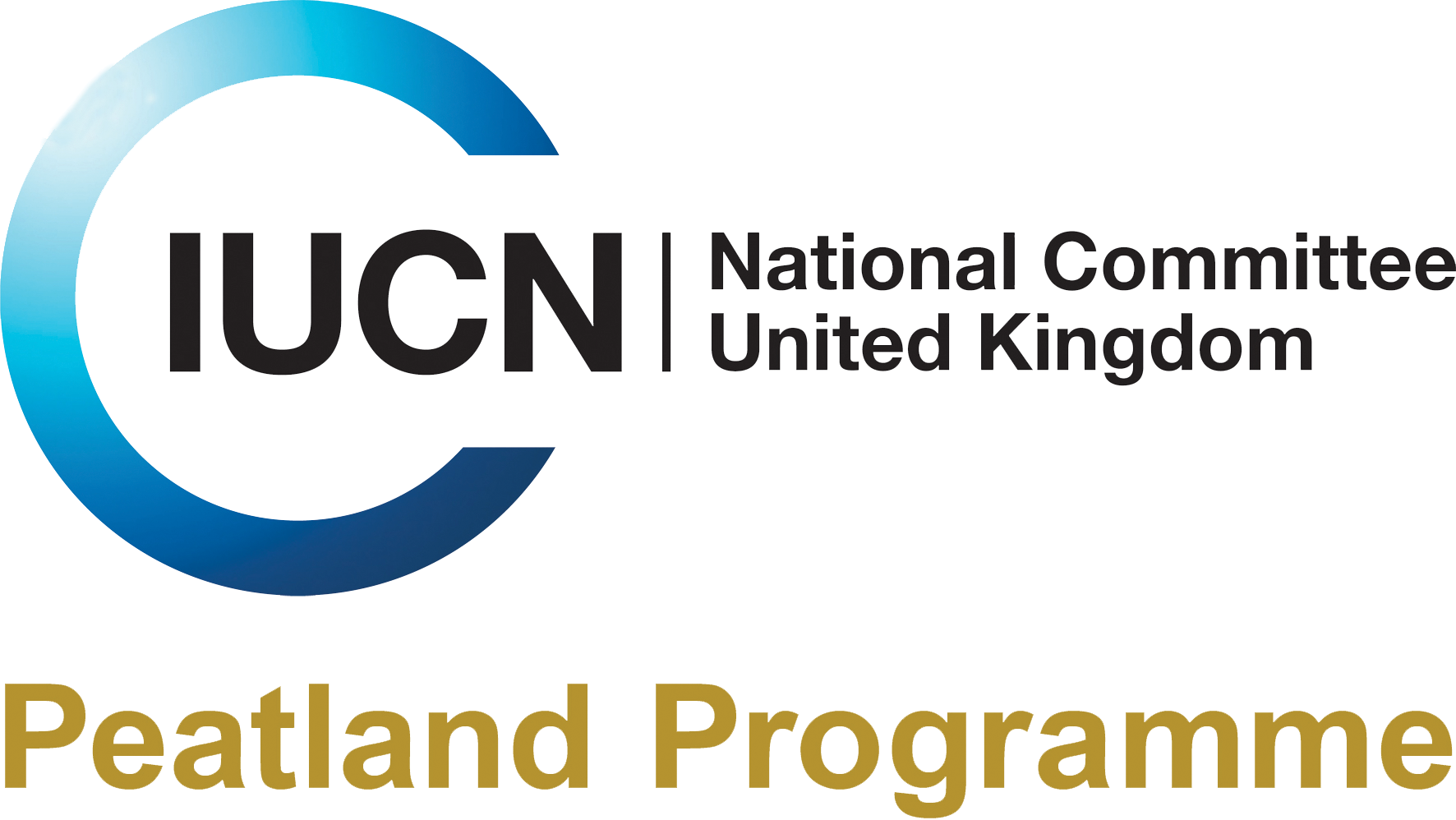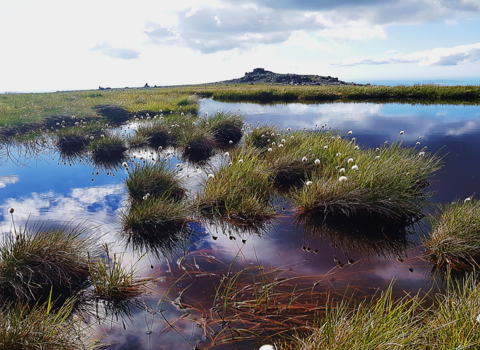“There appear to be few downsides to peatland restoration and a real potential for cost savings in providing long term public water supply. Peatland restoration offers a more sustainable future in water quality terms, as we’re addressing the causes of poor water quality, not treating the worsening symptoms.”
- Andrew Walker, Catchment Manager, Yorkshire Water
Peatlands are a major source of drinking water in the UK
The provision of water is an ecosystem service of peatlands. The British Isles are globally unique in sourcing their drinking water predominantly from peatlands - around 85% of all global drinking water sourced directly from peatlands is consumed in the UK and Republic of Ireland1. Around 43% of the UK population receives its water from peatlands1.
Peatlands are the headwaters for some of the UK’s major water supply areas (e.g. the peatlands of the Peak District provide water to Manchester and Sheffield). Water from peatlands flows directly into lakes and reservoirs. Water derived from healthy peatlands is naturally of high quality with few pollutants and low nutrient levels, requiring straightforward treatment once it reaches a water treatment plant.
Threats to water quality
Land-use pressures threaten the water provision potential of peatlands. Drainage of peatlands and removal of vegetation affect the hydrology and flow regimes, and peat exposed to air decomposes, reducing the storage capacity of peat soils in the landscape2. In the UK, peatlands which are used for water-supply are commonly also under additional land uses such as arable and livestock hill farming. This multi-purpose land use can result in compromised ecosystem service delivery for quality water1. Sediment and dissolved chemicals released from degraded peat affects the quality of water downstream. Degradation and historic pollution affect 96% of deep peatlands located in upland headwaters in England1.
Over recent decades, the amount of dissolved organic carbon (DOC), which creates the brown colour of peaty water, has doubled across many UK catchments3. Several reasons for this increase have been proposed, such as increased temperatures and decreases in acid rain – as the acidity of rainwater decreases, organic matter dissolves more easily. There is also evidence that peatland degradation and unsustainable management can contribute to colour production, with damaged peatlands being associated with higher colour. For example, dominant heather cover can lead to enhanced DOC levels in comparison to Sphagnum-dominated blanket bog vegetation4.
Dark brown water has a high dissolved organic matter content. Credit Penny Anderson
The costs of water treatment
The high concentration of dissolved organic carbon (DOC), sediment and other pollutants means that water from peatlands needs to be treated before it can be used for drinking. DOC must be removed from drinking water supplies prior to chlorination as it produces carcinogens. The removal of DOC is extremely costly - in the UK, the removal of peat-derived sediment and DOC from water originating from degraded peatlands represents the largest costs in raw water treatment1.
An example of this is the Bamford Catchment in Derbyshire, where it costs Severn Trent Water approximately £160,000 per year to remove sediment from raw water1. There are high energy costs associated with this sort of water treatment and the use of electricity has associated carbon emissions on top of those which already arise from the degraded peatland. With the threat of further peatland degradation from climate change and human activity, the future costs of treating water could be substantial, as the requirement to build new treatment works to cope with water from more degraded peatlands could cost £790,000 – £2.4 million per thousand people1.
Improving water quality through peatland restoration and sustainable management
Fortunately, there is a more sustainable solution to dealing with the pollution derived from our degraded peatlands. Future water quality and water security in the UK could be seriously compromised due to peatland degradation and climate change1. Peatland restoration and protection offer a potentially cheaper and more sustainable option to improve the quality of raw water arising from peaty catchments, avoiding costly treatments, energy and chemical use whilst also recovering the wider holistic benefits realised from peatland restoration.
Peatland restoration, particularly drain blocking, has been associated with increased biodiversity throughout a catchment, an improvement in the quality of aquatic ecosystems, and a reduced risk of flooding5,6. Over the long term, rewetting has been observed to reduce inorganic nitrogen and DOC in water, with lower levels found in rewetted sites compared to drained peatlands2. Re-vegetating bare peat can stop surface erosion in three to four years and mitigate the high loads of sediment and particulate organic carbon in water originating from degraded peatlands7.
Drain blocking can reduce the amount of dissolved organic matter escaping degraded peatlands. Credit Penny Anderson
Fen peatlands are commonly at risk of eutrophication from excessive nitrogen and phosphorous originating from agricultural activities, such as livestock grazing. For example, the Somerset Levels and Moors catchments in South West England are subject to intensive agriculture and wastewater inputs which has led to nutrient contamination of the inflow waters8. The potential of wet farming, or paludiculture, techniques to reduce excess nutrient levels are now being explored in lowland settings. The planting of paludiculture crops, such as bulrush (Typha) could be used to remove phosphorous and nitrogen from the water, and rewetting would cause further denitrification of the water8. Further experimental trials of crops are necessary to evaluate this management option, but paludiculture has potential to improve the quality of water through removing excess nutrients.
Somerset Levels. Credit Joy Russell
References
1. Xu J, Morris PJ and Liu J. Hotspots of peatland-derived potable water use identified by global analysis. Nature Sustainability. 2018; 1: 246–253. https://doi.org/10.1038/s41893-018-0064-6
2. Pschenyckyj C, Riondato E, Wilson D, Flood K, O’Driscoll C, and Renou-Wilson F. Optimising Water Quality Returns from Peatland Management While Delivering Co-Benefits for Climate and Biodiversity. Report produced for An Fóram Uisce, 2021.
3. Yallop AR, Clutterbuck B and Thacker, J. Increases in humic dissolved organic carbon export from upland peat catchments: the role of temperature, declining sulphur deposition and changes in land management. Climate Research. 2010; 45(24): 43-56. https://doi.org/10.3354/cr00884
4. Bain CG, Bonn A, Stoneman R, Chapman S, Coupar A, Evans M et al. IUCN UK Commission of Inquiry on Peatlands. IUCN UK Peatland Programme, Edinburgh, 2011.
5. Ramchunder SJ, Brown LE and Holden J. Catchment-scale peatland restoration benefits stream ecosystem biodiversity. Journal of Applied Ecology. 2012; 49: 182-191. https://doi.org/10.1111/j.1365-2664.2011.02075.x
6. Goudarzi S, Milledge DG, Holden J, Evans MG, Allott TEH, Shuttleworth EL et al. Blanket Peat Restoration: Numerical Study of the Underlying Processes Delivering Natural Flood Management Benefits. Water Resources Research. 2021; 57(4). https://doi.org/10.1029/2020WR029209
7. Labadz J, Allott TEH, Evans M, Butcher D, Billett M, Stainer S et al. Peatland Hydrology. Draft Scientific Review, 2010.
8. Comber S, Lunt P, Taylor M, Underwood N, Crocker R and Schindler R. Restoration management of phosphorus pollution on lowland fen peatlands: A data evidence review from the Somerset Levels and Moors. Agricultural Water Management. 2023; 278: 108419. https://doi.org/10.1016/j.agwat.2023.108419

